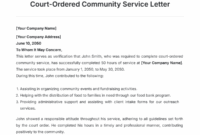Moving can be an exciting but also a little overwhelming, and among the many tasks on your to-do list, notifying your landlord properly is incredibly important. Sending a formal letter isn’t just a courtesy; it is often a contractual obligation outlined in your lease agreement. Doing it right ensures a smooth transition, helps protect your security deposit, and maintains a good relationship with your previous landlord.
Think of this formal notification as your official way of saying “I’m leaving” in a clear and documented manner. It sets the stage for everything that follows, from your final inspection to the return of your security deposit. Having a solid letter in hand gives you peace of mind and clarity, making the whole moving process a little less stressful.
Crafting Your Official Notice When It’s Time To Go
When you decide it’s time to pack up and move to a new place, one of the first and most crucial steps is to officially inform your landlord. This isn’t just about sending a quick text or making a casual phone call; a formal written notice, often guided by a reliable letter template to landlord for moving out, is usually required by your lease agreement and local tenancy laws. This document serves as your official notice to vacate the property, stating your intention to move out by a specific date. It’s your legal way of breaking ties with the current tenancy, so precision and clarity are key.
Failing to provide proper notice could lead to serious consequences, like being held responsible for additional rent even after you’ve moved out, or complications with your security deposit. Every lease agreement specifies a notice period, typically 30 or 60 days, sometimes even longer, before your lease ends or if you’re on a month-to-month arrangement. It is absolutely essential to review your lease carefully to understand these terms and adhere to them without fail.
Beyond simply stating your move-out date, this letter is also an opportunity to address other important aspects of your tenancy conclusion. You can use it to formally request a pre-move-out inspection, which allows you and your landlord to assess the property together for any potential damages before you officially leave. This can help prevent disputes over the security deposit later on by documenting the property’s condition.

Furthermore, a well-written notice should include your new forwarding address. This is vital for your landlord to send you your security deposit, any remaining mail, or other important communications after you’ve vacated the property. Without this information, there could be delays or even issues with receiving funds you’re owed. Taking the time to prepare this letter meticulously will save you a lot of hassle in the long run.
What to Include in Your Letter
- Your full name and current rental address.
- The landlord’s full name and current mailing address.
- The date you are writing the letter.
- A clear statement of your intent to vacate the property.
- Your official move-out date, ensuring it aligns with your lease agreement’s notice period.
- A request for a move-out inspection, if desired.
- Your new forwarding address for the return of your security deposit and any other mail.
- A request for the return of your security deposit, mentioning any applicable state laws if appropriate.
- Your signature and printed name.
Making Your Move-Out Process Stress-Free
Beyond simply sending your official notice, there are several practical steps you can take to ensure your moving out process is as smooth as possible. First, consider how you send your letter. While an email might seem convenient, sending your notice via certified mail with a return receipt requested provides undeniable proof that your landlord received it and on what date. This documentation can be invaluable if any disputes arise later regarding the notice period or other lease terms. Always keep a copy of the sent letter and the mailing receipt for your records.
Another crucial step is to meticulously document the condition of your rental unit before you leave. Take clear, timestamped photos or videos of every room, including walls, floors, appliances, and fixtures. Pay special attention to areas that might be prone to wear and tear or minor damage. This visual evidence serves as a powerful defense against unwarranted deductions from your security deposit, proving the condition of the property at the time of your departure.
Don’t forget about your security deposit. Most leases outline the conditions for its return, including deductions for damages beyond normal wear and tear and often, professional cleaning. Understand these terms fully. If your landlord offers a pre-move-out inspection, seize the opportunity to be present. This allows you to discuss any potential issues upfront and address them before you officially move out, potentially saving you money and disagreement down the line.
Finally, remember to leave the property in the best possible condition, following the cleanliness standards outlined in your lease. This often means thoroughly cleaning the entire unit, repairing any minor damage you may have caused, and removing all your personal belongings. A clean and well-maintained unit upon departure significantly increases the likelihood of receiving your full security deposit back and leaves a positive final impression with your landlord.
Leaving your rental home on good terms starts with clear communication and following proper procedures. By using a well-structured letter template to landlord for moving out, understanding your lease, and taking proactive steps to document the property’s condition, you set yourself up for a stress-free transition. These efforts not only protect your financial interests but also ensure you leave behind a professional and respectful impression.
Taking the time to handle these details diligently makes the entire moving experience considerably less daunting. You will be able to focus on settling into your new home with the peace of mind that comes from knowing you’ve tied up all loose ends correctly.



